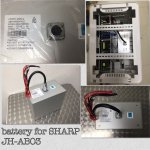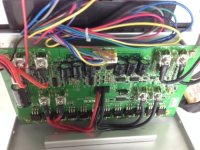Hello all, I'm new to the forum so I hope I'm posting this in the right place. Any help is greatly appreciated. 
A few months ago I purchased a battery pack from ebay that came from Sharp JH-AB03 backup power system (Link). I'm trying to figure out how to use this thing in my 24V lawn mower and maybe an ebike later. Based on what I can tell so far, this is some type of 8s configuration with a built in BMS. I charged it using a CC/CV power supply to 28.8V and then discharged it while taking readings and everything looked good.
The questions I have are about how to use it on a regular basis and the capabilities of the built in circuitry.
1. Series packs usually require balancing. Is it OK for me to assume that this function is provided by the BMS? Any way to test it? Would I be OK just charging it with a CC/CV type supply set to 28.8V and just leaving it plugged in?
2. I'm not sure if this BMS has a low voltage cut-off built in or if I need to add one. Suggestions on a safe way to test this? I ran the test to 22V but I'm sure the 2.75V per cell would be too high. I can probably open up the pack and test individual cells while discharging to see when/if it cuts power.
3. The label on the battery pack says "Output: DC25.6V 20A". I'm guessing that the 20A is the BMS limit since these batteries are typically capable of much more. I'm not sure if the BMS would limit the current to 20A or just get damaged if more than 20A was drawn. Again, any suggestions on how to test it? Would it be OK to hook this up to a motor directly with a switch or do I need to add in some current limiting capability.
A few months ago I purchased a battery pack from ebay that came from Sharp JH-AB03 backup power system (Link). I'm trying to figure out how to use this thing in my 24V lawn mower and maybe an ebike later. Based on what I can tell so far, this is some type of 8s configuration with a built in BMS. I charged it using a CC/CV power supply to 28.8V and then discharged it while taking readings and everything looked good.
The questions I have are about how to use it on a regular basis and the capabilities of the built in circuitry.
1. Series packs usually require balancing. Is it OK for me to assume that this function is provided by the BMS? Any way to test it? Would I be OK just charging it with a CC/CV type supply set to 28.8V and just leaving it plugged in?
2. I'm not sure if this BMS has a low voltage cut-off built in or if I need to add one. Suggestions on a safe way to test this? I ran the test to 22V but I'm sure the 2.75V per cell would be too high. I can probably open up the pack and test individual cells while discharging to see when/if it cuts power.
3. The label on the battery pack says "Output: DC25.6V 20A". I'm guessing that the 20A is the BMS limit since these batteries are typically capable of much more. I'm not sure if the BMS would limit the current to 20A or just get damaged if more than 20A was drawn. Again, any suggestions on how to test it? Would it be OK to hook this up to a motor directly with a switch or do I need to add in some current limiting capability.



